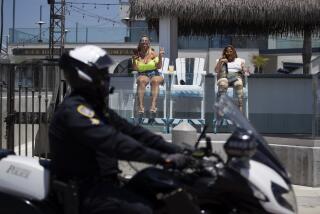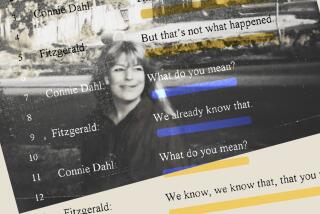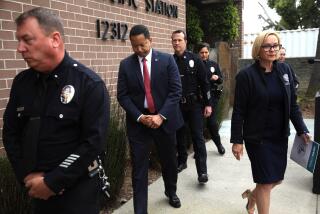What Next for Detroit? : With Rodney King in mind, officials have reacted quickly to the beating death of a black motorist. Residents watch, wait.
- Share via
DETROIT — Dirt and gravel have been scattered over the bloodstains, but there is no question that this is the spot.
This is where the mortally wounded Malice Green sat--oddly upright and still--dying in the street.
“Right here. Right here,” says a visitor to the site in this rundown residential neighborhood. “I never thought I’d see what you all seen in Los Angeles right here. “
Nor did Mayor Coleman Young. In the wake of the Rodney King beating, he and Police Chief Stanley Knox boasted that such a case was unlikely here. Not here where the mayor, police chief and more than half the force are black.
But on Nov. 5, a group of white police officers fatally beat Green, an unarmed black motorist, an eerie echo of the incident that helped to ignite the worst riots in modern U.S. history. Four officers were indicted last week in connection with Green’s death, including a black sergeant who did not participate in the attack but, prosecutors say, failed to stop it.
“Hey, we’re used to it here,” said Albert Roberts, 30, who has lived in this west side neighborhood all his life. “This is a bad, bad place to live sometimes, and bad things happen here.”
At the corner of 23rd Street and West Warren, Richard Arnold, 42, flashes the peace sign to passing cars. A few feet away, the Rev. Edward Collins, 60, paces with a portable microphone, shouting, “We are sick and tired of bein’ sick and tired, sick and tired of bein’ sick and tired. . . .”
Collins has brought his modest PA system to the scene to “wake up folks to what’s goin’ on here, to make ‘em see this is Rodney King all over again--except worse. Rodney King, he didn’t die.”
Cars line up at the curb for a drive-by view of the shrine that has been built in Green’s memory. The centerpiece is a blackboard with a hand-lettered message: “On this site, I lost a brother I never knew but deep down I know the pain. . . .”
The plaque is framed by a pair of white loafers with gold buckles, said to be Green’s favorite shoes. Someone has used a felt-tip pen to decorate the shoes with dozens of tiny black crosses.
The curious shake their heads when they see the shoes and speculate about what it will take to keep the peace here.
Although Green’s death has been compared with the King case, this city “has not become Los Angeles,” according to the Detroit Free Press, “and there is no reason that it must.”
Calling for a local trial of the officers charged in Green’s death to avoid the eruption that followed the Simi Valley acquittals in the King case, civic leaders have commended this community for reacting with “heartening calm.”
Three days after Green was killed, about 150 people turned out for a rally to peacefully protest “police brutality.” Several days later, more than 2,000 came out for Green’s funeral and a gathering afterward to chant, “No justice, no peace”--a familiar Los Angeles refrain.
Some attribute the relative calm to the absence of a videotape of this beating, as there was in the King case. Others say sub-freezing temperatures are responsible for the cooler response.
But some, including Rodney G. King himself, believe the muted public reaction here may have more to do with quick official response than with videotapes or inclement weather.
In an interview Thursday from his lawyer’s office in Santa Ana, King praised Detroit’s police chief and mayor for their fast action. Unlike some Los Angeles officials, said King, “they didn’t hesitate or say (police) had to have a motive for this (beating).”
Just last week at a University of Michigan debate, former Los Angeles Police Chief Daryl F. Gates not only defended his actions in the King case but attacked Detroit officials for their handling of the Green beating, especially the chief’s suspension of officers “before the investigation was completed. . . .”
Tearful and outraged by early reports of how Green died, Knox and Young scrambled from the start to reassure the black community that, as Knox put it, “this type of thing will not be tolerated.”
Knox swiftly suspended without pay seven officers who had been at the scene of Green’s death and publicly condemned the beating as “a senseless act.” The mayor went even further, announcing that Green was “literally murdered by police.”
Malice Wayne Green, 35, died about 30 minutes after his car was stopped by a pair of plainclothes officers known in the neighborhood as “Starsky and Hutch.” They pulled their unmarked car in front of his brown Mercury Topaz as Green, an unemployed steel worker and father of five, stopped in front of a suspected crack house to drop off a friend.
According to investigators’ accounts widely reported here, the officers leaned into the front seat and ordered Green to open his clenched hand. When he did not, he was clubbed on the hand, and later the head, with heavy metal flashlights.
The violence escalated as more officers arrived at the scene. One flagged down a rescue squad en route to another call.
But when the beating continued, a paramedic--one of four paramedics who are key prosecution witnesses--retreated to the truck to message a superior: “What should I do if I witness police brutality/murder?”
Green was pulled from the car and handcuffed. Although bleeding from two gashes in his head, Green was left sitting alone and “deadly still” in the road for nearly 15 minutes, witnesses told the Detroit News.
According to the medical examiner, Green died of multiple blunt-force injuries to the head.
The neighborhood where Green’s blood still stains the street is no stranger to violence, nor to prostitution, crack cocaine and the ravages of alcoholism.
The suspected crack house where Green was stopped by police is abandoned now, but behind it, men in threadbare overcoats still huddle next to a fire in a trash can, passing around bottles of cheap wine in brown paper bags.
It is a residential neighborhood, not far from Rosa Parks Boulevard, where few own their homes and many are unemployed. Some of the buildings here are still boarded up after the riots of the 1970s.
Detroit, the Motor City, was once also known as Murder City. But with 615 murders last year, the city has slipped in the national ranking. Los Angeles, which is three times larger than Detroit, counted 1,027 murders for 1991.
Yet it is not unusual to hear Detroit residents speak of Los Angeles as the more violent place to live.
“No question L.A. is worse, lots worse,” said Evelyn McCann, 54. “That’s what makes the cops there so bad. They gotta be cold and callous just to survive.”
In the 1960s and 1970s, many Detroiters compared their mostly white police department to an occupation force. Some officers had a habit of stopping people at random--especially black people--and frisking them for no reason, say veteran black leaders.
In the early 1970s, the force created operation STRESS (Stop The Robberies, Enjoy Safe Streets). In less than three years, STRESS officers were involved in the deaths of 20 people--17 of them black. One former STRESS officer now stands accused in the Green death.
When Coleman Young was elected Detroit’s first black mayor in 1974, it was on a platform calling for abolition of STRESS and the transformation of the 82% white police force.
Today, the chief and most of the officers are black. But as Young conceded after the Green beating, that may not be enough.
The problem, as some community leaders see it, is not black vs. white, but “(police) blue vs. everybody else,” as one city councilman put it.
In April, 1991, after the King beating, Knox issued a special order against police brutality. “Excessive and inappropriate use of force will subject members to extremely serious consequences. . ,” the order said. Officers have “a responsibility to prevent and curtail excessive use of force. . . .”
Today, Young professes shock at what has happened.
“We’re an entirely different department from Los Angeles,” the stunned mayor told a Detroit columnist. “If this could happen here, it could happen anywhere.”
Six days after Malice Green died, the Detroit News ran an unusual consumer story. On Page 5A, readers found a series of tips on how to avoid a beating if stopped by police, including “Stay in the car,” “Avoid sudden movements” and the all-important “Do not argue.”
The News also offered a few hints for officers, including “Keep your gun hand free.”
“We hope justice will prevail (in Detroit), but we’ll have to wait and see. . ,” says Rodney King.
In this neighborhood one bitter cold night last week, Malice Green’s boyhood friend Anton Cross shivered inside his leather jacket and noted, “They’re just lucky it wasn’t a hot day when this happened. Damn lucky.”
But Amase Clay, 31, doesn’t agree. “If you want to know why there aren’t thousands of people out on the street here protesting this, I’d say it’s because they didn’t see a videotape of Malice Green dying.”
Clay brought her five children to see the Green shrine for “a lesson in life.” What lesson? “Stay out of trouble, just stay out of trouble,” says Clay’s 16-year-old son Latwan.
Behind the bouquets of artificial flowers, near the portrait of Green on the front of the suspected crack house, a mourner has penned another message: “We create our own justice daily. We do.”
Death Scene in Detroit Five police officers and two paramedics saw Malice Green fatally beaten by two other officers, witnesses say. The Nov. 5 attack has evoked images of the Rodney King beating. According to police and witnesses, here is how the incident unfolded: HOW IT HAPPENED 1. At 10:30 p.m., Malice Green, 35, pulls away from a store in a run-down section of Detroit with a friend and a woman companion. 2. Two officers in an unmarked car follow Green’s 1984 Mercury Topaz. A police spokesman said the car matched the description of a stolen car. 3. About a block from the store, Green pulls in front of the friend’s home. The friend gets out as the officers, Larry Nevers and Walter Budzyn, pull in front of Green’s car. They step out and take positions on both sides of Green’s car. Nevers asks Green for his driver’s license. 4. Green reaches for the glove box. Nevers notices Green has his fist clenched and orders him to open it. 5. Officers enter the car to force Green to open his fist. The violence escalates and Green is beaten on the head. They discover he held nothing in his hand, but four rocks of crack cocaine are later found in the car. 6. Green is rolled onto the street as officers Karl Gunther and Robert Lessnau drive up. They are followed by officers Paul Gotelaere and James Kijeck and by Sgt. Freddie Douglas, the supervising officer and the only black at the scene. 7. Nevers hails an ambulance that is on its way to another emergency. 8. In the presence of the others, Nevers and Budzyn strike Green in the head with a metal flashlight five to eight times. 9. Nevers asks the paramedics to see how Green is doing. After a brief examination, the paramedic tells the officers that Green will not survive. Nevers sends the ambulance away and Douglas calls for a second ambulance. 10: At 11:06 p.m., Green is pronounced dead on arrival at Detroit Receiving Hospital.
WHERE IT HAPPENED Sources: Detroit News, Times staff reports
More to Read
Sign up for Essential California
The most important California stories and recommendations in your inbox every morning.
You may occasionally receive promotional content from the Los Angeles Times.










